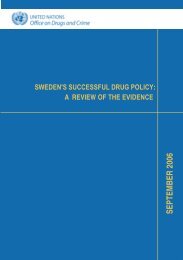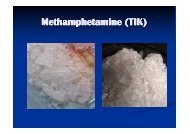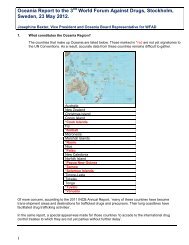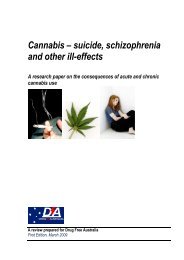International Research Compendium - Drug Free Australia
International Research Compendium - Drug Free Australia
International Research Compendium - Drug Free Australia
You also want an ePaper? Increase the reach of your titles
YUMPU automatically turns print PDFs into web optimized ePapers that Google loves.
Because of the demonstrated neurotoxicity and reports of lasting neurological<br />
disturbances of ecstasy, this drug should be considered as dangerous despite its<br />
reputation in the youth culture as safe.<br />
XTC ( Ecstasy or 3-4-methylenedioxymethamphetamine = MDMA ) has a non-linear<br />
pharmacokinetic profile.<br />
Consumption of elevated doses of the substance may produce disproportional<br />
elevation of plasma levels of XTC. Its clearance depends partially on metabolism by<br />
the liver.<br />
Between 3 – 7 % is converted to the active substance methylenedioxyamphetamine (<br />
MDA ), and 28% is biotransformed to other metabolits. Around 65% is eliminated,<br />
unchanged, via the kidneys. The half-life of XTC in plasma is 7,6 hours. 6 – 8 halflives<br />
are necessary for complete elimination of XTC, giving a total time of around 48<br />
hours for the drug to be completely eliminated.<br />
A plasma level of 8 mg/l ( severe intoxication ):<br />
More than 24 hours would be necessary to decrease to a plasma level lower than 1<br />
mg/l, which produces less clinical effects. Therefore, 24 hours would be the<br />
estimated time of intensive care needed by intoxicated patients who had taken a few<br />
XTC capsules.<br />
This effect appears to be dose-related. But it is clear that any dose is not safe.<br />
The effects of XTC are related to several neurotransmitters including serotonin,<br />
dopamine and norepinephrine. (release of dopamine is increased )<br />
Serotonin plays the main role in mediating the effects of XTC.<br />
There is increased serotonin release because XTC binds to and blocks the serotonin<br />
transporter, thus blocking serotonin reuptake. Eventually, this leads to long-term<br />
depletion of serotonin.<br />
XTC may reduce gray matter in key brain regions<br />
A small study using a new imaging technique revealed an association between<br />
MDMA abuse and lower gray matter density in key brain structures that affect<br />
language, movement, and vital functions such as breathing and heartbeat. serotonin<br />
promotes the growth of neurons and glial cells, which together comprise the brain’s<br />
gray matter.<br />
They showed smaller concentrations of gray matter in the MDMA abusers than in the<br />
controls. Subtle but statistically significant differences were seen in several brain<br />
regions.<br />
Regions with less gray matter were parts of the neocortex, the cerebellum, and the<br />
brainstem.<br />
Tolerance develops rapidly with the use of XTC, and some individuals use<br />
progressively larger amounts of XTC to reinforce its psychological effect. But there is<br />
no tolerance to the physical collateral effects.<br />
For 2 – 3 days following XTC use there may be residual effects associated with acute<br />
withdrawal of the drug: Muscle stiffness and pain, headache, nausea, loss of<br />
appetite, blurred vision, dry mouth and insomnia. Psychological effects may also be<br />
observed, most commonly depression, paranoia, anxiety, panic attacks, fatigue,<br />
difficulty in concentrating.<br />
Impairments of memory, decision-making and self-control are observed. There can<br />
also be major hepatic and cardiovascular effects and impairment of body temperature<br />
control.<br />
Alcohol<br />
35






